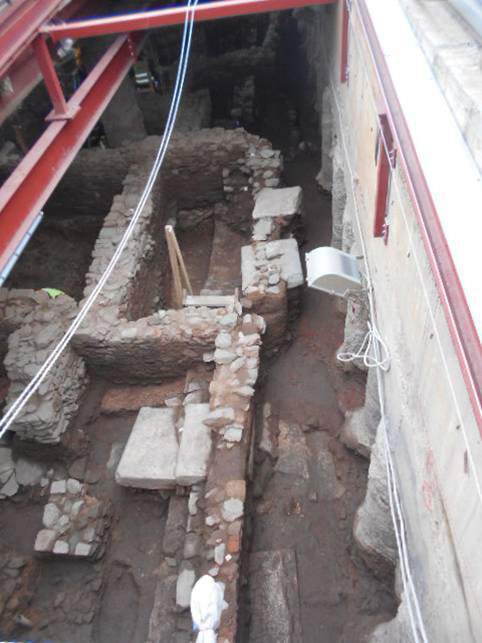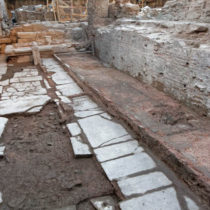On January 23, 2018, the Central Archaeological Council (KAS) discussed the enhancement of the fountain-house which has been revealed at the north entrance of the Agia Sofia station during construction works of the Thessaloniki Metropolitan Railway.
On the occasion of this discussion, which will be continued next Tuesday, the Association of Greek Archaeologists (SEA) has published a letter about the matter, which had been sent to the KAS members.
The text of the letter reads:
“After the fountain-house, which had come to light during the construction works of the Thessaloniki metro at the eastern part of the northern entrance of the Agia Sofia station, adjacent to the north building line of Decumanus Maximus (now Egnatia street) and at the eastern side of the stoa of the marble-paved S-shaped square, has been excavated, it was found that it is a very significant monument, which belongs to the type of a nymphaeum.”
”The monumental nymphaeum, which was a two-storey building, dominated at a central spot of the city, west to the crossroad of the city’s imposing Decumanus Maximus and Cardo. Adorned with niches that hosted statues, like other important nymphaea of Constantinople and Antioch, it seems that it has been the main fountain where the city and the crowds of passengers quenched their thirst, in the heart of the religious-administrative centre of the cosmopolitan metropolis Thessaloniki, which co-reigned the Byzantine Empire.
”In the two-storey monument (15.45×1.80 m, height: 2.84 m) successive building phases can be seen from the 4th to the 7th c. AD. In the beginning the building had a linear façade. Later it became more complex in its form with a U-shaped ground plan and jamps consisting of impressive relief coffers. Nine semicircular niches were built in its lower part, while higher, on the storey, rectangular niches alternate with semicircular and ellipsoid ones. Of the two parts of the U, the eastern one remains unexcavated due to technical reasons.
”According to the Ministerial Decision of May 2017, and after the opinion given by KAS, the conservation of the S-shaped square and its enhancement along with the well-preserved building remains of the Middle Byzantine workshops, west to the fountain-house, had been decided. Regarding the fountain-house, which had been revealed partly as to its height, closed in between the Byzantine walls, its removal and repositioning in the same place was decided.
”The big importance of the monument for the city’s topography from the 4th till the 7th century, according to recent excavation data, makes it vital that a proper technical solution for the in situ preservation of the monument be found and no re-examining the matter of ‘whole or partial repositioning’, which in our opinion calls into question even the condition of the aforementioned Ministerial Decision to remove and reposition the whole monument [and not part of it]. The example of the Historical Crossroad’s rescue at the Venizelos station, after the SEA, the Municipality of Thessaliniki and an array of other institutions have taken action supporting the archaeologists, has shown that there are always possible technical solutions for rescuing monuments, without hindering the proceeding of construction works, especially when decisions are made quickly without delays and pressure.
”For these reasons the Association of Greek Archaeologists thinks that the best technical solution should be found, one that will not abolish the station, one that will be safe for the passengers and will also enhance the monument in situ, without it being mutilated, its presence being a landmark of Thessaloniki and therefore will work in favor of the city.
”Once more we remind that this subway line was decided despite the clear warnings of the Archaeological Service about the particularly important antiquities which will be found in its course, about which we underline that there has to be a holistic approach based on the future best use of all monuments that have come to light in the area. The constitutional demand for their protection and enhancement is the one to impose changes in the technical work. The constitutional demand, which the Archaeological Service is called to serve, cannot be treated as a ‘delaying’ of the work. The results of the Venizelos station example have proved that antiquities should not be regarded as an obstacle to development, as they add value, uniqueness and singularity to the environment of important works, as in the case of the Thessaloniki metro”.



